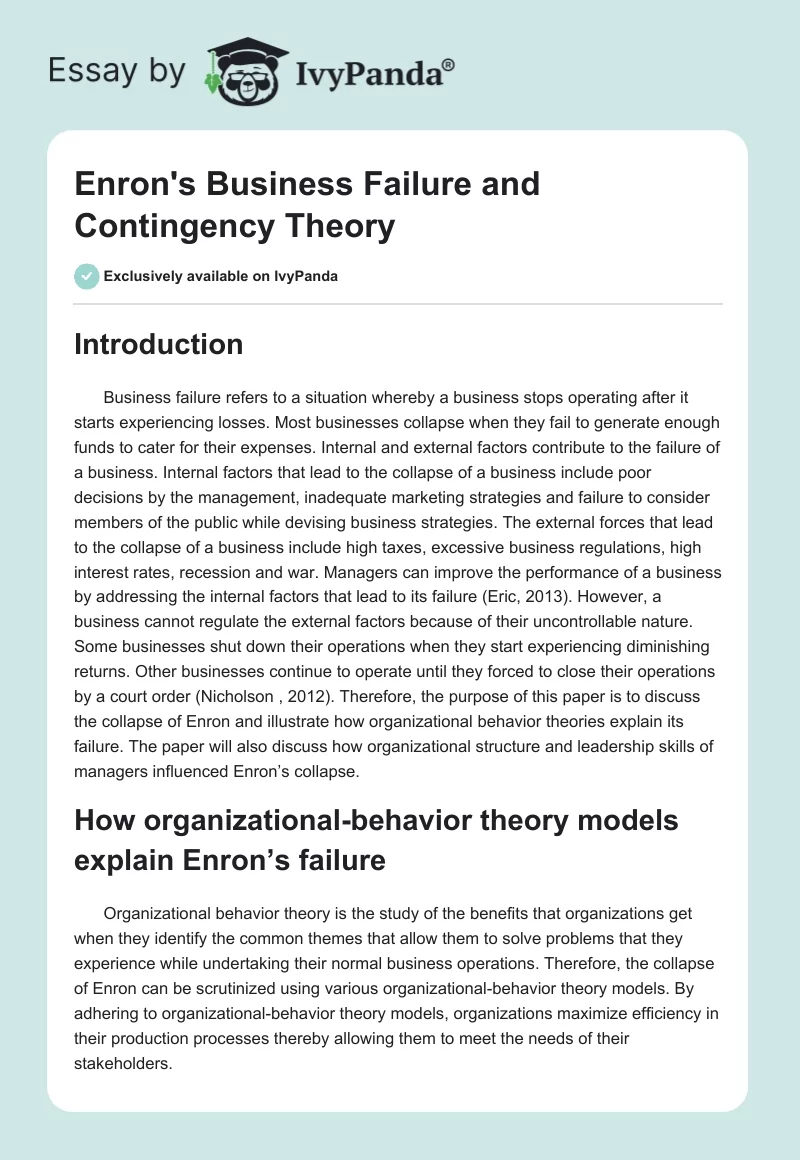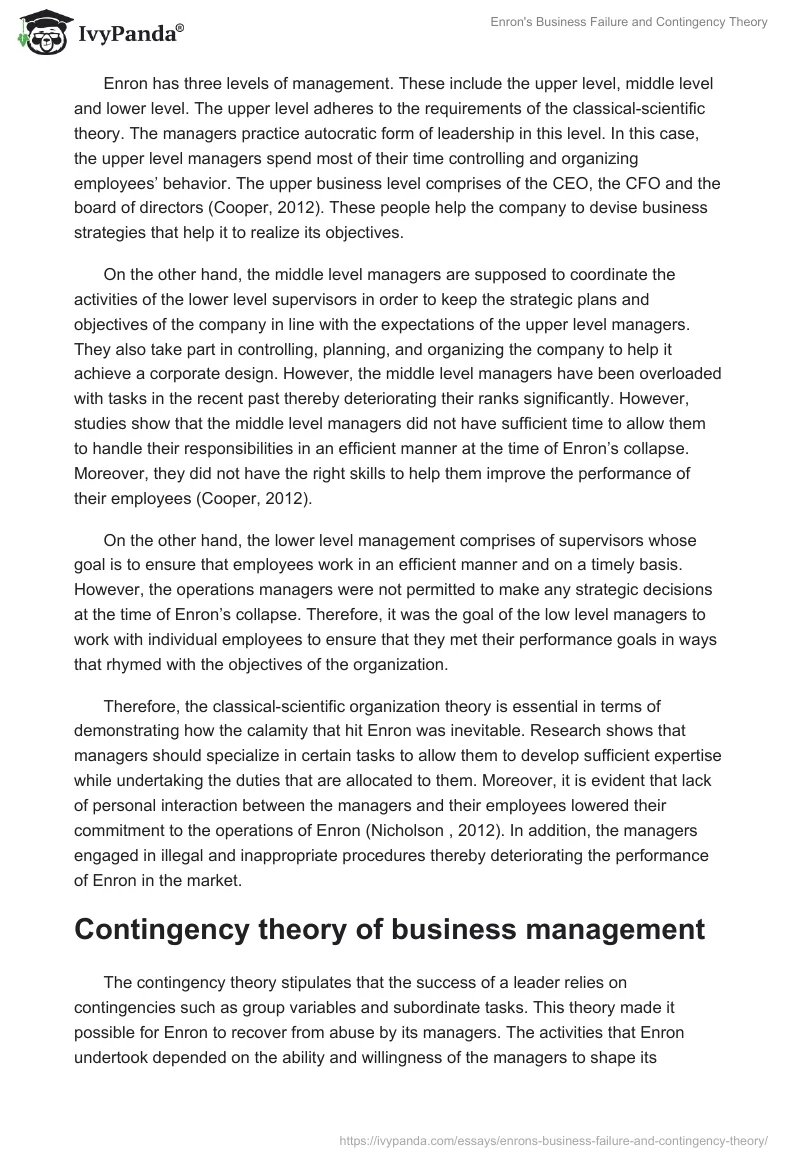Introduction
Business failure refers to a situation whereby a business stops operating after it starts experiencing losses. Most businesses collapse when they fail to generate enough funds to cater for their expenses. Internal and external factors contribute to the failure of a business. Internal factors that lead to the collapse of a business include poor decisions by the management, inadequate marketing strategies and failure to consider members of the public while devising business strategies.
The external forces that lead to the collapse of a business include high taxes, excessive business regulations, high interest rates, recession and war. Managers can improve the performance of a business by addressing the internal factors that lead to its failure (Eric, 2013). However, a business cannot regulate the external factors because of their uncontrollable nature. Some businesses shut down their operations when they start experiencing diminishing returns. Other businesses continue to operate until they forced to close their operations by a court order (Nicholson , 2012). Therefore, the purpose of this paper is to discuss the collapse of Enron and illustrate how organizational behavior theories explain its failure. The paper will also discuss how organizational structure and leadership skills of managers influenced Enron’s collapse.
How Organizational-Behavior Theory Models Explain Enron’s Failure
Organizational behavior theory is the study of the benefits that organizations get when they identify the common themes that allow them to solve problems that they experience while undertaking their normal business operations. Therefore, the collapse of Enron can be scrutinized using various organizational-behavior theory models. By adhering to organizational-behavior theory models, organizations maximize efficiency in their production processes thereby allowing them to meet the needs of their stakeholders.
Enron has three levels of management. These include the upper level, middle level and lower level. The upper level adheres to the requirements of the classical-scientific theory. The managers practice autocratic form of leadership in this level. In this case, the upper level managers spend most of their time controlling and organizing employees’ behavior. The upper business level comprises of the CEO, the CFO and the board of directors (Cooper, 2012). These people help the company to devise business strategies that help it to realize its objectives.
On the other hand, the middle level managers are supposed to coordinate the activities of the lower level supervisors in order to keep the strategic plans and objectives of the company in line with the expectations of the upper level managers. They also take part in controlling, planning, and organizing the company to help it achieve a corporate design. However, the middle level managers have been overloaded with tasks in the recent past thereby deteriorating their ranks significantly. However, studies show that the middle level managers did not have sufficient time to allow them to handle their responsibilities in an efficient manner at the time of Enron’s collapse. Moreover, they did not have the right skills to help them improve the performance of their employees (Cooper, 2012).
On the other hand, the lower level management comprises of supervisors whose goal is to ensure that employees work in an efficient manner and on a timely basis. However, the operations managers were not permitted to make any strategic decisions at the time of Enron’s collapse. Therefore, it was the goal of the low level managers to work with individual employees to ensure that they met their performance goals in ways that rhymed with the objectives of the organization.
Therefore, the classical-scientific organization theory is essential in terms of demonstrating how the calamity that hit Enron was inevitable. Research shows that managers should specialize in certain tasks to allow them to develop sufficient expertise while undertaking the duties that are allocated to them. Moreover, it is evident that lack of personal interaction between the managers and their employees lowered their commitment to the operations of Enron (Nicholson , 2012). In addition, the managers engaged in illegal and inappropriate procedures thereby deteriorating the performance of Enron in the market.
Contingency Theory of Business Management
The contingency theory stipulates that the success of a leader relies on contingencies such as group variables and subordinate tasks. This theory made it possible for Enron to recover from abuse by its managers. The activities that Enron undertook depended on the ability and willingness of the managers to shape its operational resources thereby allowing it to address the needs of its employees, customers, and shareholders in an efficient manner. However, the managers at Enron engaged in abuse of power thereby lowering the productivity of their employees. In this case, it is true that power and influence drive an organization into the direction that the managers desire (Nicholson , 2012). Moreover, an organization can make use of power and influence to improve its production processes.
How Poor Leadership, Management, and Organizational Structures Contributed to Enron’s Collapse
Studies reveal that the management structure of Enron is autocratic in nature. In this case, the managers of the company abused power by failing to address the needs of their employees in an appropriate manner. Therefore, the leadership styles that the managers of the company adopted were inappropriate. Moreover, the upper and lower-level managers did not meet the expectations of their employees since they failed to respond to their needs in an appropriate manner (Eric, 2013). Therefore, when the efficiency of Enron’s managers deteriorated, the productivity of the employees worsened thereby leading to the collapse of the organization.
References
Cooper, O. (2012). A Failure of Leadership and Organization-Enron and Others. Web.
Eric, R. (2013). Leadership at Enron. Web.
Nicholson , J. (2012). What Caused Enron to Collapse? Web.


